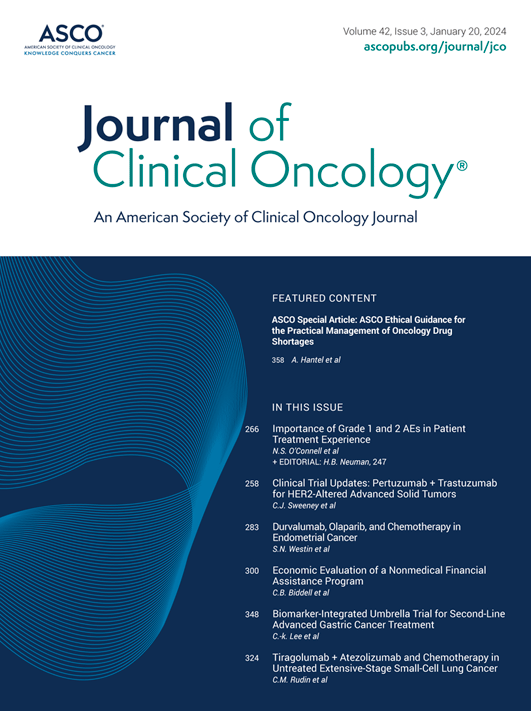激素受体阳性乳腺癌后母乳喂养:来自POSITIVE试验的结果。
IF 42.1
1区 医学
Q1 ONCOLOGY
引用次数: 0
摘要
目的:在POSITIVE试验中,我们研究了早期激素受体阳性(HR+)乳腺癌妇女的母乳喂养模式、行为及其与乳腺癌(BC)结局的关系。患者和方法positive是一项前瞻性试验,该试验表明,在中断内分泌治疗(ET)试图怀孕的早期HR+ BC妇女中,BC事件的短期风险没有增加。我们描述了母乳喂养的频率、持续时间和侧边性,并通过母乳喂养状况估计BC事件的累积发生率。结果在41个月的中位随访中,317例患者至少有1例活产,其中313例符合本分析的条件。313例患者中有196例(62.6%)为母乳喂养。167名接受保乳手术的妇女中有130名(77.8%)母乳喂养,130名中有90名(69.2%)仅用未受影响的乳房进行母乳喂养。146名接受单侧乳房切除术的妇女中有66名(45.2%)是母乳喂养的。35岁以上妇女的母乳喂养频率较高(67.6% vs 55.7%),未生育的妇女母乳喂养频率较高(66.4% vs 48.5%)。196名妇女中有103名(52.6%)母乳喂养第一个活产婴儿的时间为40个月(中位数为4.4个月;95% CI, 4.0 ~ 5.3)。母乳喂养组和非母乳喂养组在研究中首次活产后24个月的BC事件累积发生率分别为3.6%和3.1%(差异0.5%;95% CI, -4.3%至5.2%)。结论:在阳性组中,三分之二的乳腺癌诊断后分娩的妇女母乳喂养,大多数持续4个月或更长时间。在早期随访中,我们没有观察到母乳喂养的妇女与未母乳喂养的妇女在bc相关事件中的差异。这些结果对希望在BC后继续怀孕和哺乳的妇女至关重要。本文章由计算机程序翻译,如有差异,请以英文原文为准。
Breastfeeding After Hormone Receptor-Positive Breast Cancer: Results From the POSITIVE Trial.
PURPOSE
We investigated breastfeeding patterns, behaviors, and association with breast cancer (BC) outcomes in women with early hormone receptor-positive (HR+) BC who had a live birth in the POSITIVE trial.
PATIENTS AND METHODS
POSITIVE is a prospective trial that demonstrated no increased short-term risk of BC events in women with early HR+ BC who interrupted endocrine therapy (ET) to attempt pregnancy. We describe the frequency, duration, and laterality of breastfeeding and estimate the cumulative incidence of BC events by breastfeeding status.
RESULTS
At a median follow-up of 41 months, 317 patients had at least one live birth and 313 were eligible for this analysis. A total of 196 of 313 (62.6%) patients breastfed. A total of 130 of the 167 women (77.8%) who had breast-conserving surgery breastfed, and 90 of 130 (69.2%) breastfed from the unaffected breast only. Sixty-six of the 146 women (45.2%) who underwent unilateral mastectomy breastfed. The frequency of breastfeeding was higher in women older than 35 years (67.6% v 55.7%) and in those without previous children (66.4% v 48.5%). Over half (103 of 196, 52.6%) of women breastfed their first live birth for >4 months (median 4.4 months; 95% CI, 4.0 to 5.3). The cumulative incidence of a BC event at 24 months from first on-study live birth was 3.6% and 3.1% in the breastfeeding and nonbreastfeeding groups, respectively (0.5% difference; 95% CI, -4.3% to 5.2%).
CONCLUSION
In POSITIVE, two thirds of women who gave birth after BC diagnosis breastfed, mostly for 4 months or more. In early follow-up, we did not observe differences in BC-related events in women who breastfed compared with those who did not. These results are key for women who wish to pursue pregnancy and breastfeeding after BC.
求助全文
通过发布文献求助,成功后即可免费获取论文全文。
去求助
来源期刊

Journal of Clinical Oncology
医学-肿瘤学
CiteScore
41.20
自引率
2.20%
发文量
8215
审稿时长
2 months
期刊介绍:
The Journal of Clinical Oncology serves its readers as the single most credible, authoritative resource for disseminating significant clinical oncology research. In print and in electronic format, JCO strives to publish the highest quality articles dedicated to clinical research. Original Reports remain the focus of JCO, but this scientific communication is enhanced by appropriately selected Editorials, Commentaries, Reviews, and other work that relate to the care of patients with cancer.
 求助内容:
求助内容: 应助结果提醒方式:
应助结果提醒方式:


